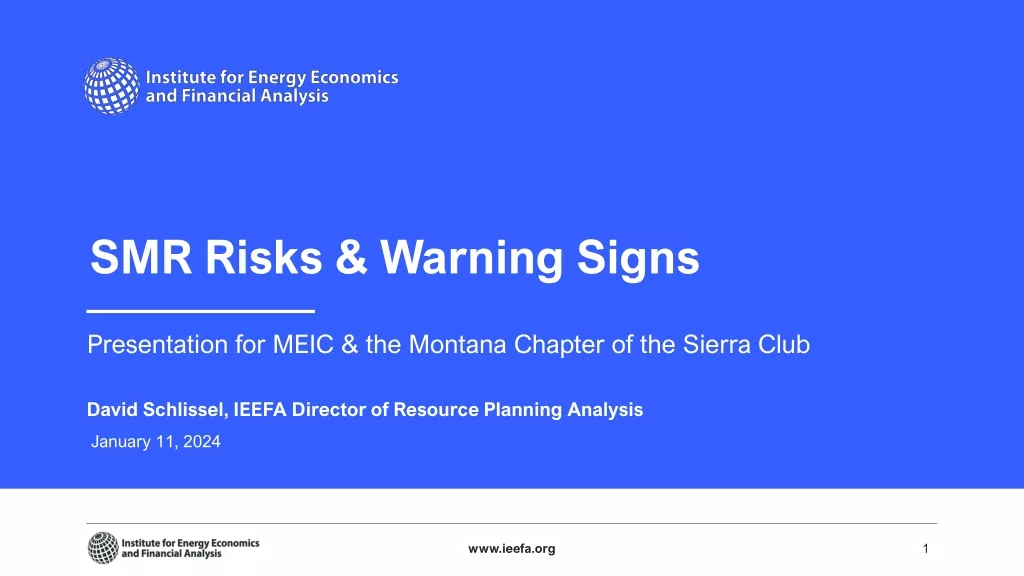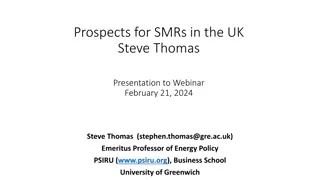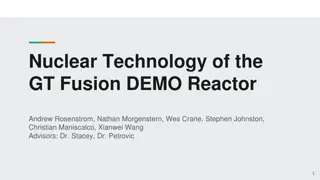Preoperative Bone Health Assessment in Spine Fusion Surgery
This presentation by Dr. Mark L. Prasarn focuses on the importance of assessing preoperative bone health in older patients undergoing spine fusion surgery. It covers the potential bone-related complications, osteogenesis process, osteoconduction, osteoinduction, and the favorable biomechanical envir
1 views • 67 slides
Risks and Warning Signs of Small Modular Reactors (SMRs)
Small Modular Reactors (SMRs) are nuclear reactors with a power capacity of 300 megawatts or smaller. Despite potential benefits, there are significant risks associated with SMRs, including cost overruns, schedule delays, lack of construction, and high power prices. The industry's track record raise
4 views • 22 slides
Insights on Fragment Spin Generation in Fission: What We Know
Considerable insight was generated from a recent conference on fission, shedding light on crucial theoretical and experimental aspects. Key topics include angular momentum, fission-fragment spin references, and the dynamics of nuclear fission. Theoretical advancements like the TDSLDA model and super
3 views • 41 slides
Exploring Fission Near 198Pb with AT-TPC at FRIB: Insights from Curtis Hunt
Delve into the intriguing world of fission studies near 198Pb using the AT-TPC at FRIB. Supported by the DOE Office of Science, this research probes nuclear structure, fission properties, and fusion-fission reactions. By employing innovative techniques like the Heavy Isotope Tagger and active target
1 views • 39 slides
Research Program on Spin Polarized Nuclei in Fusion Plasmas
Examination of spin polarized fuel in fusion plasmas to enhance energy production efficiency. Planned experiments aim to measure the lifetime of polarized nuclei for optimized fusion reactions. Key aspects include depolarization mechanisms, neutral beam heating, and fueling techniques with pellets.
1 views • 36 slides
Investigating Be Dust Generation for Fusion Reactors
Investigate the properties of beryllium (Be) dust particles generated using milling techniques for fusion reactors. The study involves analyzing particle size, morphology, crystal orientation, and thermal behavior of Be dust in air and water environments. Laboratory experiments will be conducted to
2 views • 5 slides
Reactor Sizing and Conversion in Chemical Engineering
This chapter explores the sizing of Continuous Stirred Tank Reactors (CSTR) and Plug Flow Reactors (PFR) using conversion values and overall conversion. It covers the definition of conversion, batch reactor design equations, design equations for flow reactors, and more. The content delves into the m
0 views • 17 slides
Understanding Nuclear Fusion and Fission in Atoms
Nuclear fusion is the process where two atomic nuclei combine, releasing energy and forming a new element. This process occurs in stars where hydrogen fuses to create heavier elements. On the other hand, nuclear fission involves the splitting of an atomic nucleus, releasing energy. Understanding the
3 views • 35 slides
Advanced Fission Experiments at University of Michigan
The University of Michigan, under the guidance of Dr. Sara A. Pozzi, conducts cutting-edge fission experiments leveraging organic scintillation detectors. These detectors offer advantages such as nanosecond-scale response times, energy proportionality, and scalability. The experiments focus on impro
0 views • 4 slides
INFUSE Program Overview: Public-Private Partnership for Fusion Energy
The Innovation Network for Fusion Energy (INFUSE) Program, initiated by the Office of Fusion Energy Sciences, is a Public-Private Partnership (P3) designed to facilitate access to DOE laboratory capabilities for companies in fusion energy research. This program, modeled after successful DOE P3 initi
0 views • 12 slides
Advancing Sustainable Nuclear Energy in Central Europe with Fast Reactors
Explore the potential of G4 fast reactors for advancing sustainable nuclear energy in Central Europe. Learn how fast neutron spectrum reactors can help address uranium stock depletion, waste elimination, and fuel cycle closure. Discover the regional long-term solution proposed for V4 countries and t
0 views • 12 slides
Development of Cumulative Fission Yield Covariances for Uncertainty Quantification
This study by A.A. Sonzogni and E.A. McCutchan focuses on developing cumulative fission yield covariances for uncertainty quantification in nuclear reactors. The research involves calculating cumulative fission yields, using decay data and nuclear databases, to improve accuracy in predicting fission
0 views • 5 slides
Introduction to Reactor Physics and Nuclear Fission
Explore the fundamentals of reactor physics, neutron interaction, and nuclear fission in this virtual training course on criticality safety management. Delve into the history of nuclear fission, symbolisms for atoms, and the significance of critical reactors like Fermi's Chicago Pile. Gain insights
0 views • 73 slides
Advanced Burner Reactor Concept and Subcritical SABR Design
Discusses the rationale behind fusion-fission hybrid fast burner reactors, focusing on the SABR concept for spent nuclear fuel transmutation. The SABR design aims to address challenges in nuclear power generation, waste disposal, and fuel efficiency by utilizing a subcritical advanced burner reactor
0 views • 15 slides
Insights on Small Modular Reactors (SMRs) in the UK
Steve Thomas presents an overview of Small Modular Reactors (SMRs), highlighting the challenges and misconceptions surrounding their development and commercial availability. The discussion covers various claims about SMRs, their categorization, and the current status of Advanced Modular Reactors (AM
0 views • 17 slides
NRC Licensing of Advanced Reactors and NuScale Small Modular Reactor Design Overview
Overview of NRC licensing process for advanced reactors, including a focus on Small Modular Reactors under 10 CFR Parts 50 and 52. Details on licensing options, such as Conceptual Design Assessment and Prototype Plants, are discussed. NuScale's Small Modular Reactor design, featuring passive safety
4 views • 12 slides
Advancements in Fusion Reactor Technology: A Comprehensive Overview
This presentation delves into the nuclear design aspects, objectives, background, and state-of-the-art components of the GT Fusion DEMO Reactor project. It covers key areas such as tritium breeding ratio, neutron transport, temperature distribution, and material choices for optimal reactor performan
0 views • 31 slides
Key Fusion Reactions in Nuclear Astrophysics
Fusion reactions play a crucial role in nuclear astrophysics, with key reactions involving light elements such as Li, Be, B, and stable carbon isotopes. Understanding fusion of light heavy nuclei at extreme energies is essential for predicting stellar evolution. The S-factor provides a convenient re
0 views • 31 slides
Implementation of Angular Momentum Formalism in Low-Energy Fusion Reactions
This update focuses on integrating the angular momentum formalism into low-energy fusion reactions using the LISE++ platform. It explores fission barriers, potential energy pockets, compound formation, and de-excitation processes in fusion reactions. The documentation delves into fusion residue tran
0 views • 25 slides
Effectiveness of Np-237 Transmutation in QUINTA Setup
Np-237 transmutation effectiveness in the QUINTA setup depends on beam particle type and energy. The challenging nature of Np-237, with a long half-life and accumulation in nuclear waste, necessitates fission for disposal. Neutron capture results in the production of other actinides, making fission
0 views • 20 slides
Study of Nuclear Fission Process Through Gamma-Ray Spectrometry
Delve into the nuclear fission process through prompt gamma-ray spectrometry, exploring motivations, experimental data, and preliminary results. Understand the gamma heating process in nuclear reactors and its significance in reactor safety. Contextualize the study within Generation III+ and IV reac
0 views • 86 slides
Understanding Tooth Fusion in Dentistry
Tooth fusion is the merging of two tooth germs into a single large crown, which can be complete or incomplete depending on the developmental stage. It can affect primary dentition, mostly incisors and canines. Differentiating fusion from gemination involves examining the pulp chambers. Causes may in
0 views • 9 slides
Fusion Science Department Enabling Research Projects 2021-2023
The Fusion Science Department Enabling Research Projects for 2021-2023 focus on developing novel fusion-relevant scientific and technological ideas. These projects, led by Principal Investigators, are distinct from main work packages and involve scientific planning, team collaboration, and resource
0 views • 11 slides
Understanding Hydrogen Isotope Influence on H-Mode Confinement in Fusion Plasmas
Knowledge of how the hydrogen isotope impacts H-mode confinement is crucial for predicting energy confinement in future fusion plasmas. Research explores the relationship between isotope mass and confinement time, highlighting the optimistic outlook for future reactors. Experimental studies on hydro
0 views • 13 slides
Optimizing Operator Fusion Plans for Large-Scale Machine Learning in SystemML
The research focuses on optimizing fusion plans for large-scale machine learning in SystemML. It discusses the motivation behind fusion opportunities, the need for optimizing fusion plans, and system architecture considerations. The study emphasizes the challenges in heuristic fusion planning for co
0 views • 17 slides
Exploring Nuclear Fusion and Stellar Evolution
Nuclear fusion is a powerful process where atomic nuclei combine to form larger atoms, releasing significant energy. Stars like the Sun rely on fusion to generate energy, creating new elements in the process. The death of a star can lead to the formation of heavier elements that eventually contribut
0 views • 21 slides
Understanding Nuclear Reactions: Fission, Fusion, and Energy Release
This content covers various aspects of nuclear reactions, including nuclear fission, fusion reactions, the Manhattan Project, and examples of reactions involving different particles and elements. It explains concepts like exoergic and endoergic reactions, conservation of charge and nucleon number, a
0 views • 34 slides
Understanding Nuclear Reactions: Fusion, Fission, and Energy Production
Explore the fundamental concepts of nuclear reactions, including fusion and fission, the conversion of mass into energy, and the role of fusion in energy production. Discover how the sun and stars shine through fusion reactions and how we can replicate this process on Earth using isotopes of hydroge
0 views • 6 slides
Introduction to Chemical Reaction Engineering (CRE)
Chemical Reaction Engineering (CRE) focuses on studying the rates and mechanisms of chemical reactions, as well as designing reactors for these reactions. The field involves understanding balances in terms of molar flow rates, mole balances, rate laws, stoichiometry, and membrane reactors. Membrane
0 views • 20 slides
Advanced Plasma Control Strategies for Fusion Reactors Weekly Meeting
Explore proposals on divertor plugging, effect of planar coil currents, Poincare maps, and main goal of loading PFCs for fusion reactors. The discussions aim to enhance plasma control strategies and optimize reactor performance.
0 views • 6 slides
Innovations in Reprocessing Spent MOX Fuel for Sustainable Nuclear Energy
Discussion at the FR22 Conference focuses on the potential for fast reactors to modify the isotopic composition of plutonium from spent MOX fuel of PWRs. By utilizing fast reactors like BN-800, countries can alter the fissile isotopes in plutonium, enabling its reuse in thermal reactors and effectiv
0 views • 8 slides
Chemical Reactor Design: Unsteady State and Nonisothermal Reactors
Developing energy balances for unsteady state and nonisothermal reactors is essential for designing efficient chemical reactors. The energy balances involve terms such as heat flow, work done, energy accumulation, and mass flow, which impact the reactor's performance. By considering factors like pha
0 views • 29 slides
Understanding Nuclear Fission Cross Sections
Nuclear fission cross sections play a crucial role in determining reaction rates in nuclear reactors and experiments. They represent the probability of nuclear interactions when neutrons collide with a nucleus, impacting fission and capture rates. These cross sections are influenced by factors such
0 views • 15 slides
Progress Update on Nuclear Data Research at LLNL
Nuclear Data Advisory Group received an online report from Lawrence Livermore National Laboratory detailing progress on various projects, including thermal neutron scattering laws processing, fission data measurements, and PPAC fission chamber development for 240Pu. The report outlines successful te
0 views • 19 slides
Understanding Nuclear Fission: Process, Examples, and Energy Generation
Nuclear fission involves the splitting of an atomic nucleus, with uranium-235 being a commonly used fissile material. When uranium-235 undergoes fission, it produces fission fragments, neutrons, gamma radiation, and kinetic energy. The fission process can be initiated by absorbing a slow-moving neut
0 views • 19 slides
Proposal for Comprehensive Functional Testing of Blanket Modules in Fusion Reactors
The proposal discusses the need for advanced functional tests of blanket modules in fusion reactors due to the delay in the ITER program. Emphasizing the importance of early nuclear functional testing, it suggests considering partial models for assessments beyond tritium release, such as nuclear hea
0 views • 4 slides
Introduction to Chemical Reaction Engineering
Chemical Reaction Engineering (CRE) is crucial for understanding how chemical reactors operate in various processing operations. This field involves reactor design by integrating factors such as thermodynamics, kinetics, fluid mechanics, heat transfer, and economics. CRE aims to effectively design a
0 views • 16 slides
Reactor Design Equations: Basics and Applications
This material covers the foundational concepts of reactor design equations, focusing on molar balance in batch reactors, continuous stirred tank reactors (CSTRs), and plug flow reactors (PFRs). Through detailed explanations and illustrative examples, you will gain a comprehensive understanding of ho
0 views • 20 slides
Plutonium Burning Fast Reactors for Reducing PWR Stockpile
Workshop presenting the utilization of plutonium burning fast reactors to decrease PWR irradiated assemblies stockpile through the CAPRA project. The performance and impact on plutonium inventory are assessed, highlighting the potential reduction and the additional reprocessing and manufacturing req
0 views • 16 slides
Development of EIRENE-NGM for Neutral Gas Dynamics in Fusion Reactors
EIRENE-NGM project focuses on enhancing the neutral gas dynamics model for fusion reactor simulations, including efficient HPC utilization, physics basis refinement, database improvement, interface development, and predictive capability validation. Collaborators from various institutes aim to create
0 views • 17 slides







































